Spider Collector's Journal (33rd page: 2023) Copyright © 2023 by Rod Crawford
Here's the 33rd page of narratives of fun (and not so fun) trips to collect spiders for research at the Burke Museum, some accompanied by capable field volunteers: Laurel Ramseyer and new recruits. Most also appeared in Scarabogram, newsletter of "Scarabs: The Bug Society." Dates of field trips head each paragraph. Maps showing the location of sites within Washington state follow the grid system outlined in the Washington Spider Checklist. RETURN TO INDEX
Where you see this button ![]() in a
field trip account, click it to get a page of collecting site photos!
in a
field trip account, click it to get a page of collecting site photos!
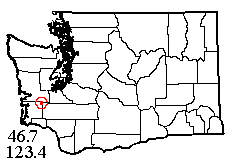 |
![]() 17 III 2023: After a miserable winter with nary a day of suitable field conditions, Laurel and I finally got a chance to breathe some field air! I'd made a plan for the vicinity of Brooklyn in the North River Valley, Pacific County, involving a cemetery, two tracts of working forest and other possible sites. Weather was as clement as one might hope, and the valley, reached by miles of gravel road crossing the north end of the Doty Hills (all working forest), was incredibly peaceful. But habitats were not exactly of the best.
17 III 2023: After a miserable winter with nary a day of suitable field conditions, Laurel and I finally got a chance to breathe some field air! I'd made a plan for the vicinity of Brooklyn in the North River Valley, Pacific County, involving a cemetery, two tracts of working forest and other possible sites. Weather was as clement as one might hope, and the valley, reached by miles of gravel road crossing the north end of the Doty Hills (all working forest), was incredibly peaceful. But habitats were not exactly of the best.
The North River Cemetery was smaller than expected and offered limited habitats. Still, Laurel got three species (including the undescribed, pallid Lepthyphantes she sought) from those inverted metal vases recessed into the gravestones, while I beat at least 6 from varied shrubs.
Some other pre-selected sites were fenced or entry-restricted, but good old Port Blakely Timber had the standard hiking-allowed at their property on Howard Creek. Unfortunately, there was just enough cutleaf blackberry to sharply limit our access to potentially good habitats away from the road. I was able to reach enough alder litter to sift, getting 8 species, but only introduced Microneta viaria was present in any numbers. Fern understory also produced 8 species, but not invasive-dominated. Salal understory added 2 more and the steel gate we parked by, another 2. Laurel was able to reach plenty of siftable moss on alder trunks, and that was the best habitat with 15 species, but some of the standard moss spiders were absent, and she got only one juvenile of her Ozyptila crab spiders. The moss sample did include two of the day's 3 best spiders, single females of undetermined Walckenaeria and Entelecara. She also managed to reach one bit of the streamside sedge marsh, where her 4 species included one female of rare Porrhomma terrestre. I got more species (9) from conifer foliage, but all duplicated other habitats. Total so far, 37.
Now that school was out for the day, it was Laurel's idea to end our visit collecting outside the buildings of historic (1897) Brooklyn School. To the tune of a noisy dog from across the road, we added 5 different species from the buildings, and at the very end I found one Coreorgonal under a concrete chunk while Laurel got an uncommonly long-lived hobo spider under a rock. The school brought us up to 44 species! And it was Laurel's first time collecting in Pacific County.
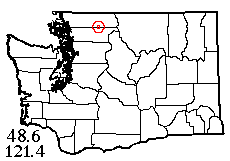 |
![]() 29 III 2023: This week, just one good day was predicted, with even that one not good in all places. So on Wednesday, Jerry Austin and I chose a North Cascades site expected to be about as dry as you can get in March, the north end of Bacon Creek Road just before its permanent washout at Jumbo Creek. We reached the turnoff (via Darrington) easily, and at first encountered nothing worse than the usual potholes. Then, after crossing Oakes Creek via one of those newfangled "trough culverts", we found our way barred by a whole cluster of slender windfalls (alders and hemlocks). Here's where my folding backpacker saw came in handy! Between us we sawed through all that barred the way, with the thickest trunk just high enough off the road to slip under. A few lesser branches and rocks were movable, and with little further ado we reached the place where a side road (with a deep gully in it) led down to a bridge across the creek. We had total solitude here all day. It was mostly-sunny, warm (in the 60s) and no habitats were wet. Ideal, right?
29 III 2023: This week, just one good day was predicted, with even that one not good in all places. So on Wednesday, Jerry Austin and I chose a North Cascades site expected to be about as dry as you can get in March, the north end of Bacon Creek Road just before its permanent washout at Jumbo Creek. We reached the turnoff (via Darrington) easily, and at first encountered nothing worse than the usual potholes. Then, after crossing Oakes Creek via one of those newfangled "trough culverts", we found our way barred by a whole cluster of slender windfalls (alders and hemlocks). Here's where my folding backpacker saw came in handy! Between us we sawed through all that barred the way, with the thickest trunk just high enough off the road to slip under. A few lesser branches and rocks were movable, and with little further ado we reached the place where a side road (with a deep gully in it) led down to a bridge across the creek. We had total solitude here all day. It was mostly-sunny, warm (in the 60s) and no habitats were wet. Ideal, right?
The riparian forest floor was paved with leaf litter! I set up to sift at the edge of the gully — and got 3 spiders from two bags-full! Were conditions this winter too severe for litter spiders at the site? Anyway, I switched over to sifting moss, and that was halfway decent — but only halfway, 8 species, 2 of which I also got on the bridge.
There was some sword fern understory around, usually an excellent habitat, but the ferns here looked kind of sad, not very lush and plastered to the ground or the banks. Beating them, I got the same 2 species I got from the bridge, and one other! As the sun dipped behind the western ridge of the canyon, I started beating conifer foliage, at this site almost entirely western hemlock. Jerry had been spending most of his time doing the same on the other side of the creek. Between us we got 9 species from hemlock, 3 duplicating the prior fern catch. Jerry had also found two good species under loose bark, one of them Bathyphantes alascensis which I haven't seen in a long time. But our total was an inadequate 18 species. Can't win them all! At least we had fun.
Possibly we could have kept on as much as another hour, but the prospect of doing the rough, obstacle-course road out in the dark quashed that idea. At least we reached Darrington in time for a nice sunset. Fortunately, there is another gridspace to sample almost adjacent to this one, so a return trip later in the season will probably enable me to bag both!
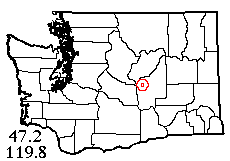 |
![]() 8 IV 2023: Laurel wanted to check whether her cemetery spider occurs in eastern Washington, and we'd made a plan centering on the town of Quincy in Grant County. This Saturday was predicted partly-sunny and 59° there, a nice change from the steady west-side rains. Alas for predictions! We arrived to find no sun and a wind chill making it feel like 40. Quincy Cemetery, whose sign admonishes one to preserve its "dignity, beauty and serenity," looked stark and barren. Laurel managed to get 3 species (not the one she sought) from the recessed vases, while I got one from under a valve cover and one other from a row of cedar shrubs. We moved on to the grounds of a nearby medical center, where I found nothing new on junipers and Laurel added three more from pine cones. Now we drove north into farmland seeking an enclave of natural habitat. In vain! I'd preselected a potential sagebrush site, all destroyed now. Though we were on public land, locals in trucks acted suspicious. Another site, at the end of "Road R," featured a field that was impossible to sweep due to stiff thistle, and some rock rubble yielding nothing but juvenile salticids.
8 IV 2023: Laurel wanted to check whether her cemetery spider occurs in eastern Washington, and we'd made a plan centering on the town of Quincy in Grant County. This Saturday was predicted partly-sunny and 59° there, a nice change from the steady west-side rains. Alas for predictions! We arrived to find no sun and a wind chill making it feel like 40. Quincy Cemetery, whose sign admonishes one to preserve its "dignity, beauty and serenity," looked stark and barren. Laurel managed to get 3 species (not the one she sought) from the recessed vases, while I got one from under a valve cover and one other from a row of cedar shrubs. We moved on to the grounds of a nearby medical center, where I found nothing new on junipers and Laurel added three more from pine cones. Now we drove north into farmland seeking an enclave of natural habitat. In vain! I'd preselected a potential sagebrush site, all destroyed now. Though we were on public land, locals in trucks acted suspicious. Another site, at the end of "Road R," featured a field that was impossible to sweep due to stiff thistle, and some rock rubble yielding nothing but juvenile salticids.
Our remaining hope was my second pre-selected site, a tiny triangle of habitat south of town bordered by West Canal, crops, and "Road 9." There was a nice-looking grove of non-native elm here, with plenty of litter to sift, but the first two bags had no spiders; the one spot in the woods that did produce any, had one species also taken from the cemetery and pine cones, and one good record, first finding of the non-native wolf spider Trochosa ruricola in the Columbia Basin. Laurel had somewhat better luck, adding 4 species from much grass-sweeping, and the best luck of all looking under wood, where she got a black widow and a single small female of an apparent new Drassyllus species. I got nothing from tumbleweeds but juvenile Philodromus, and nothing under rocks.
We had some daylight left, so we headed north out of town on "Road Q." Just before the gated entrance of a gun club, was a considerable tract of fairly natural sagebrush! However, a half-hour's beating produced nothing but juveniles. Sweeping roadside grass brought only one identifiable species, Dictyna coloradensis, already taken at West Canal. With a long drive home, we gave up the ghost with only 15 species. However, we did have that new Drassyllus; another consolation was delicious burgers in Easton!
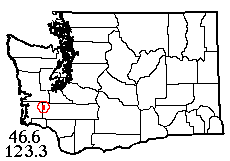 |
![]() 25 IV 2023: Midway down the west border of Lewis County, at the little-traveled end of Elk Creek Road before entering Weyerhaeuser's vast Pe Ell Tree Farm, is a place called Murnen: a few houses and no businesses. Having blinked, we barely noticed it. Soon we were in a publicly accessible clearcut just inside the tree farm, hoping for a good set of conifer-foliage spiders; and 11 species duly rewarded us. Clearcut grass and sedge (4 species) added nothing, but the site also gave me the season's first mature wolf spider.
25 IV 2023: Midway down the west border of Lewis County, at the little-traveled end of Elk Creek Road before entering Weyerhaeuser's vast Pe Ell Tree Farm, is a place called Murnen: a few houses and no businesses. Having blinked, we barely noticed it. Soon we were in a publicly accessible clearcut just inside the tree farm, hoping for a good set of conifer-foliage spiders; and 11 species duly rewarded us. Clearcut grass and sedge (4 species) added nothing, but the site also gave me the season's first mature wolf spider.
Our main site was to be a mile back toward Murnen, at a bridge over substantial Elk Creek. Here, in peace and quiet except for an occasional log truck still shedding dust from the tree farm roads, I sifted litter (largely from scattered maple trees), getting a rather sparse 7 species, while Laurel sifted moss from tree trunks (12 species) and "clods" fallen from the canopy (5 species plus some juveniles of her favorite group Ozyptila). Understory, of ferns, salal and Oregon-grape, in the open forest between the road and the creek gave me a nice 6 species, and a fine sweep sample from riparian grass added 2 more. Foliage of the mature conifers along the road, even though somewhat dusty, added 4 not taken in the clearcut. An adjacent rock quarry with pond added no more species, but had some interesting sights inclding possible turtle tracks on underwater mud. Although no one habitat was extremely rich, in all we took a quite nice 42 species in the Murnen area!
Laurel just had to stop at another graveyard, so on the way back to I-5 we visited hilltop Claquato Cemetery, where she promptly scored her undescribed grave-vase spider and several others, some adding to a good sample that I and a student helper had taken nearby back in 1991. Near the west edge of the cemetery, I found a surprising population of native solitary bees hovering around the stones! And how nice to end our jinx with a successful day!
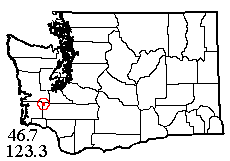 |
![]() 27 IV 2023: More than a month ago, Shane Sater, a Montana naturalist, was visiting friends in Seattle and stopped at my lab to learn a bit about spiders. He couldn't do a field trip then, not having his car, but on his repeat visit this month he had it! Wanting to make up for lost time, I set my trip with Shane for 2 days after the Murnen trip with Laurel. The destination was easy, the unsampled tract of working forest we'd passed through on the March trip to Brooklyn Valley. The day was perfect, and at an intersection about halfway across the range of hills, I saw habitats I thought we should check out. A clearcut to the south required a permit for entry, but the side road north, through well-developed alder-maple stands with some conifers and diverse understory, had no signs or barriers.
27 IV 2023: More than a month ago, Shane Sater, a Montana naturalist, was visiting friends in Seattle and stopped at my lab to learn a bit about spiders. He couldn't do a field trip then, not having his car, but on his repeat visit this month he had it! Wanting to make up for lost time, I set my trip with Shane for 2 days after the Murnen trip with Laurel. The destination was easy, the unsampled tract of working forest we'd passed through on the March trip to Brooklyn Valley. The day was perfect, and at an intersection about halfway across the range of hills, I saw habitats I thought we should check out. A clearcut to the south required a permit for entry, but the side road north, through well-developed alder-maple stands with some conifers and diverse understory, had no signs or barriers.
We parked and proceeded to my usual first order of business, sifting litter. The leaf litter here was really great, thick and moist and rich! Sifting two bags of alder and one bag of the less-abundant maple litter, got us 11 species, with Shane helping point out specimens and learning about the diversity that lives in this underfoot habitat. Next I gathered a big bag of alder and maple moss while Shane got a smaller one from conifers; sifting produced 12 species. Meanwhile, Shane had spotted the one mature Metellina in her web that we saw all day, and had a mature salticid dangling from his hat. With the sifting all done, we chased wolf spiders for a while in the muddy entry to the forbidden clearcut. At this point we had 26 species.
Now mid-afternoon, I wanted to divide and conquer, so I set Shane to sweeping roadside grass and herbs (he'd brought his own sweep net, so I assumed he knew how) and I descended into a shady ravine to beat hanging fern understory. Result, 11 species from the ferns and 16 from the roadside! Then, after we had a pleasant conversation with a couple of friendly, curious bikers who'd paused at our intersection, we took a "back door" (not posted) to an edge of what may or may not have been the forbidden clearcut. Between us we beat 15 species from Douglas-fir foliage. I later learned that there were small wetlands within walking distance of our site, but didn't know that at the time. As it was, we got a fine total of 46 species, though nothing very rare. The trip home was uneventful except that Shane discovered a Grays Harbor County speed trap! Fortunately the county cop was merciful and just gave him a warning.
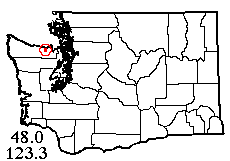 |
![]() 2 V 2023: On a fine-weather day, we crossed the ferry, stopped near Sequim for a brief sample at Sequim View Cemetery (adding 5 species to the Sequim sample), then turned south on Deer Park Road for sites just outside Olympic National Park. My main goal was a tract of meadow and riparian land belonging to the city of Port Angeles. Alas, all posted "No Trespassing, Danger, Old Munitions." Thanks to Laurel's later research, we learned the tract was used for army training early in World War II, and five years later two boys were killed when they sawed into a shell embedded in a log. Since that time, the area's been inspected and cleared five times, but now the owners consider it too dangerous! Oh well, it's a wide world with alternate spider habitats to be had.
2 V 2023: On a fine-weather day, we crossed the ferry, stopped near Sequim for a brief sample at Sequim View Cemetery (adding 5 species to the Sequim sample), then turned south on Deer Park Road for sites just outside Olympic National Park. My main goal was a tract of meadow and riparian land belonging to the city of Port Angeles. Alas, all posted "No Trespassing, Danger, Old Munitions." Thanks to Laurel's later research, we learned the tract was used for army training early in World War II, and five years later two boys were killed when they sawed into a shell embedded in a log. Since that time, the area's been inspected and cleared five times, but now the owners consider it too dangerous! Oh well, it's a wide world with alternate spider habitats to be had.
Our first collecting site was a 2019 state clearcut not far north of the park border, with more Douglas-fir foliage than one could shake a net at. Beating the trees got me no less than 15 good species. The poor trees had much worse to contend with than that — target shooters, not content with cans and stumps, had shot off the ends of young branches in most of the trees I saw! Anyway, one common wolf spider was active in the clearcut, and Laurel beat two spider additions from overhanging ferns and shrubs, swept three more from herbs, and found 3 more (the best ones) under debris, for 24 total at this site.
Back up the road toward the coast highway, we'd passed a blocked logging road into a good-sized timberland tract. The tract is now accessed from the other side and this road is now a trail, complete with trail improvements, and no sign that the owners care. We walked up a short way and were able to sift litter and moss while still within sight of the car. I got a diverse-enough 8 species from litter (it was especially good in the shade of big boulders anchoring the gate), while Laurel added 11 more from relatively dry moss. A vast array of understory ferns was available, and produced 7 species, 3 adding to the list. While I was fern-beating, Laurel swept trailside grass and herbs (2 additions) and got one more from aerial webs. Our total from the 2 sites, 49 species, unusually good results from "second choice" habitats.
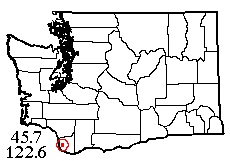 |
![]() 9 V 2023: A long drive south to Clark County was prompted by Laurel's desire to pursue her two research projects there, and determine whether the cemetery vase spider and/or introduced crab spider Ozyptila praticola occur there. Our first stop was the cemetery, buildings and woodland at Bethel Methodist Church near Ridgefield; a lovely spot and reasonably peaceful even though not far from the freeway. Douglas-firs bordering the lawn had hanging foliage within easy reach, yielding 7 species with Philodromus rufus really abundant. Pardosa vancouveri were active near the lawn's edge, and a small tract left unmowed produced Misumena. Laurel found 2 species, one of them the uncommonly-collected Tricholathys rothi, on gravestones, and just a few spiders in the vases (but including the one she sought).
9 V 2023: A long drive south to Clark County was prompted by Laurel's desire to pursue her two research projects there, and determine whether the cemetery vase spider and/or introduced crab spider Ozyptila praticola occur there. Our first stop was the cemetery, buildings and woodland at Bethel Methodist Church near Ridgefield; a lovely spot and reasonably peaceful even though not far from the freeway. Douglas-firs bordering the lawn had hanging foliage within easy reach, yielding 7 species with Philodromus rufus really abundant. Pardosa vancouveri were active near the lawn's edge, and a small tract left unmowed produced Misumena. Laurel found 2 species, one of them the uncommonly-collected Tricholathys rothi, on gravestones, and just a few spiders in the vases (but including the one she sought).
As is now customary, I sifted maple litter (very sparse, likely due to invasive earthworms, except under one specific tree) while Laurel sifted moss from the trees; between us we got 10 species, including the only specimen of invasive Philodromus dispar. The various church buildings had varied small spiders on the outer walls, including two non-native jumping spider species that were first found, not long ago, in Snohomish County far to the north. I had 5 prior records from this area, since once upon a time I had several caving friends here, so adding these to the 26 new records gave us an adequate 31-species sample. The one Ozyptila specimen proved to be the native O. pacifica.
In the few hours left before our long voyage home, we decided to visit another cemetery, a larger urban one in eastern Vancouver called Evergreen Memorial Gardens (shhh, don't mention the word cemetery). This was too well-groomed to yield many spiders, but did have the subterranean Lepthyphantes and brought the local sample there from 2 up to 7.
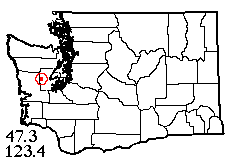 |
![]() 16 V 2023: In 2021 we'd sampled at Fir Creek in southeastern Olympic National Forest. Today's destination was the next gridspace west, at the sources of Vance Creek (not so high in elevation, around 1400'). The forest road access was not too rough (though we had to toss off some freshly fallen rocks) but very crooked (over 8 miles to traverse a straight-line distance of 4) and just about deserted today. The site where we stopped had a mid-sized clearing; alder, maple and conifers; and a few patches of snow in the ravine bottoms! Two woodpeckers kept it from being silent. To begin with, Laurel and I sifted tree trunk moss and leaf litter respectively, for 5 litter species to which the moss added 9, including a hard-to-find male of tiny Trogloneta sp. #2.
16 V 2023: In 2021 we'd sampled at Fir Creek in southeastern Olympic National Forest. Today's destination was the next gridspace west, at the sources of Vance Creek (not so high in elevation, around 1400'). The forest road access was not too rough (though we had to toss off some freshly fallen rocks) but very crooked (over 8 miles to traverse a straight-line distance of 4) and just about deserted today. The site where we stopped had a mid-sized clearing; alder, maple and conifers; and a few patches of snow in the ravine bottoms! Two woodpeckers kept it from being silent. To begin with, Laurel and I sifted tree trunk moss and leaf litter respectively, for 5 litter species to which the moss added 9, including a hard-to-find male of tiny Trogloneta sp. #2.
I tapped dead wood in the forest, adding two species, and beat three more additions from fern understory. Laurel worked the foliage of western hemlock saplings in the forest shade, adding four more, and tapped fully 100 fallen Douglas-fir cones to get one solitary spider (it was Euryopis formosa, adding to the list). I beat the not-too-abundant sun-exposed conifer foliage, only 3 of the species taken adding to the list, but one of those was a quite rare Dipoena, D. malkini or maybe something new! Late in the afternoon, wolf spiders finally became active in the clearing, where between us we got two Pardosa species. One Laurel found under charred firewood turned out to be one of the same. But she added two more orbweavers from aerial webs, bringing our site total to 32. (One specimen taken by me in the opposite corner of the area, back in 1972, makes it 33.)
On the way home we stopped at a large cemetery in Tumwater, co-managed by three organizations who must have been passing the buck on vase maintenance; most of the vases were full of soil and debris, yielding only two spider species, not the one for Laurel's project. And the delay embroiled us in a traffic jam in south Seattle! But we enjoyed our day of solitude on Vance Creek.
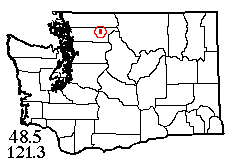 |
![]() 24 V 2023: As luck would have it, Laurel was unavailable until the weekend but Jerry was ready to go. He happily agreed to return to the area of Bacon Creek in the North Cascades, where we hadn't quite managed a sample in March. But he was disappointed that I didn't want to return to the same spider-poor site at the very end of the rough road! Instead, we went a shorter distance into the 8614 gridspace and stopped just after fording Oakes Creek. As with the previous site, only hemlock was available for the conifer foliage beat, but despite the sparse fauna I added two species not taken before, one the microspider Pocadicnemis pumila which seemed common at this site. I was hoping to get Ozyptila for Laurel and sifted a bunch of moss, but in vain; the moss here added nothing to the March sample. Jerry and I both beat fern/shrub understory for a combined total of 12 species, adding two more and upgrading our March total from 18 to 22! Not a very spider-rich area, and moreover the skies intermittently sprinkled us with a light drizzle. Anyway, we succeeded.
24 V 2023: As luck would have it, Laurel was unavailable until the weekend but Jerry was ready to go. He happily agreed to return to the area of Bacon Creek in the North Cascades, where we hadn't quite managed a sample in March. But he was disappointed that I didn't want to return to the same spider-poor site at the very end of the rough road! Instead, we went a shorter distance into the 8614 gridspace and stopped just after fording Oakes Creek. As with the previous site, only hemlock was available for the conifer foliage beat, but despite the sparse fauna I added two species not taken before, one the microspider Pocadicnemis pumila which seemed common at this site. I was hoping to get Ozyptila for Laurel and sifted a bunch of moss, but in vain; the moss here added nothing to the March sample. Jerry and I both beat fern/shrub understory for a combined total of 12 species, adding two more and upgrading our March total from 18 to 22! Not a very spider-rich area, and moreover the skies intermittently sprinkled us with a light drizzle. Anyway, we succeeded.
Near the mouth of the creek, gridspace 8513 had no prior records. Could we swing a sample there in what time remained? Luckily, the spot I picked to stop (not far up the road from the highway, where traffic was very light fortunately) was good. It was a riparian maple forest with massive, mossy trunks, and dry with the sky starting to clear. Roadside conifers were diverse, and with both of us beating, rather quickly produced 11 spider species. Sifting was again lackluster here; moss added 3 species and maple litter, which looked good but was very spider-poor, added only one. The understory foliage had more of the same.
But I had very different habitats "up my sleeve" farther south; across the highway was a powerline clearing and the gravel bar just above where Bacon Creek flows into the mighty Skagit River, and unexpectedly a wide sand-bar area as well. I thought to get a nice sweep sample along the powerline road; surprise, it only added Tetragnatha laboriosa! But extensive searching finally revealed what I was really looking for, a grove of Christmas tree-sized Douglas-firs facing the sunny clearing. From these, I beat a very nice 13 species, 12 of which added to our 15 from the maple forest site. Some very interesting records there, too! Jerry, working on the sand bar, beat 4 species from willows and managed to collect three different wolf spider species (2 on the sand, one on the gravel bar); the most notable was a major inland range extension for Arctosa perita. On upper Bacon Creek we could only boost 18 to 22, but on the lower creek we went from 0 to 32 that same day!
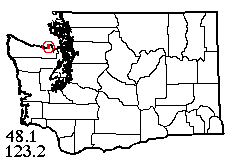 |
![]() 27 V 2023: For some time, I've hoped I could collect at Green Point, a private nature reserve on the coast between Port Angeles and Sequim. This year I finally contacted the foundation that manages the place and, after a few exchanges of email, got the desired permission. We were set to go, but had to cancel the first time due to a wind forecast. Finally we ended up going, of all times, on the Saturday of Memorial Day weekend! Thankfully we hit no traffic jams and only had to wait one hour for the ferry. I texted Jennifer the resident caretaker that we were coming, and in due course she welcomed us with utmost cordiality. Parking by the home of the late original owners, we walked down an old road toward the beach.
27 V 2023: For some time, I've hoped I could collect at Green Point, a private nature reserve on the coast between Port Angeles and Sequim. This year I finally contacted the foundation that manages the place and, after a few exchanges of email, got the desired permission. We were set to go, but had to cancel the first time due to a wind forecast. Finally we ended up going, of all times, on the Saturday of Memorial Day weekend! Thankfully we hit no traffic jams and only had to wait one hour for the ferry. I texted Jennifer the resident caretaker that we were coming, and in due course she welcomed us with utmost cordiality. Parking by the home of the late original owners, we walked down an old road toward the beach.
Laurel hit the open beach first, but without finding much. Driftwood and beach wrack produced only a few spider species expected on vegetation. But she had better luck in capturing an elusive wolf spider, Pardosa lowriei (after one had eluded me). They are very adept at hiding among the beach cobbles! I tried sweeping dune grass on the sand and a back-beach marsh, with no result! But then our luck improved markedly. Sweeping grass along the trail gave me 7 species (but sweeping a buttercup meadow, almost nothing). Where the trail skirted the bluff at the mouth of Siebert Creek, salal on the steep slope gave me 9 species including two different Meioneta. Sitka spruce on the same slope had 10 species, adding three. Having bagged 17 species in all, we moved inland to a riparian maple forest and clearing a few hundred feet up the creek.
In the maple forest, naturally I started by sifting maple litter, adding 7 species. Laurel added 2 from the walls of a couple of old cabins and 5 from sifting moss (including a Linyphantes I haven't figured out yet). We both moved onto one of the creek gravel bars, where I added one by sweeping and we each found one comparatively rare species by turning rocks, Bathyphantes malkini for Laurel and Saaristoa sammamish for me. I finished up at the riparian site by beating rich fern understory. The ferns had so many spiders that I didn't have time to beat very many, but still got 14 species! While I was doing that, Laurel beat some dense conifer foliage (largely true firs) up above and added 6 more species, three of which, again, will need further study. We had a fine day in a great place (where we barely, as they say, scratched the surface), and came away with a very good 45-species sample.
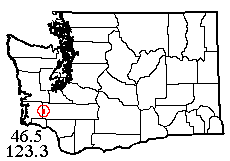 |
![]() 3 VI 2023: Many years ago, I got a unique series of wolf spider Pardosa californica on the banks of the Chehalis River downstream of the town of Pe Ell. Just upstream of Pe Ell is a place where the new Willapa Hills Trail crosses the river, and I hoped I could get another locality for the species there. Today seemed like a good time to try it. First we stopped at a cemetery not far from the trail, where we got a nice head start of 10 species including Laurel's ubiquitous grave-vase spider. Then, after some dithering about where to park, we left the car at a highway-equipment site between our two goals on the rail-trail, and hiked! Perhaps a mile and a half eastward, past roadside, woodland and pasture land, we hit the Chehalis River bridge. But I hadn't taken the trouble to look up the height of the bridge: at 76 feet, it's the highest bridge on the whole trail! No easy way down for geezers…
3 VI 2023: Many years ago, I got a unique series of wolf spider Pardosa californica on the banks of the Chehalis River downstream of the town of Pe Ell. Just upstream of Pe Ell is a place where the new Willapa Hills Trail crosses the river, and I hoped I could get another locality for the species there. Today seemed like a good time to try it. First we stopped at a cemetery not far from the trail, where we got a nice head start of 10 species including Laurel's ubiquitous grave-vase spider. Then, after some dithering about where to park, we left the car at a highway-equipment site between our two goals on the rail-trail, and hiked! Perhaps a mile and a half eastward, past roadside, woodland and pasture land, we hit the Chehalis River bridge. But I hadn't taken the trouble to look up the height of the bridge: at 76 feet, it's the highest bridge on the whole trail! No easy way down for geezers…
But even with my original goal out of reach, it was a great spot to collect. Laurel got 7 species from the bridge railings and added 2 from Douglas-fir cones. I swept 10 from grass between the trail and adjacent pastures (including an unknown Ceraticelus) and beat 9 from Scots broom, including C. fissiceps and Theridion differens. Grassland having brought us up to 27 species, we were ready for forest, and retraced our steps on the trail to head westward. Uniquely, I actually had cell phone service in this farmed countryside, and had to pause to handle a call from someone who thought she had a "spider bite"!
In a section where the trail loops away from the highway, we stopped in a lovely, peaceful forest of bigleaf maple between Rock Creek (one of dozens so named) and a pond. Here, I sifted 4 species from maple litter and Laurel sifted 8 from moss, getting a solitary male of her second special goal, crab spider Ozyptila pacifica. Sword fern understory was dense on the rail-cut slopes above, and fern-beating brought me a fine 15 species, while Laurel's sweeping the grass understory component added one more that was different. One last species from a retaining wall near the car was introduced Entelecara acuminata. In all, we had a highly successful 46 species. (Alas, we can't recommend the place we stopped for burgers at the southernmost Chehalis exit. They just can't seem to keep competent help there!)
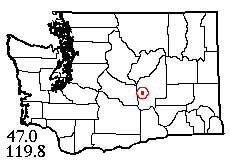 |
![]() 10 VI 2023: A wet spell in western Washington sent us over the Cascades to an unadventurous goal: Martha Lake, just off the freeway and 1.5 miles NE of the town of George. On the way, we made a cemetery stop in Cle Elum. "What's the name of this cemetery?" I asked. "Oh, I suppose it has a name," Laurel answered coyly. The grave vases of Laurel Hill Cemetery yielded 4 interesting species, but not the undescribed lepthyphantine she sought. Now at Martha Lake, the forecast was for a sprinkle of rain in the morning, but drying by the time we arrived. Guess what, we found most of the foliage still soaked. But litter to sift was available in quantity! First, I sifted a bag of litter from a large Russian-olive stand and didn't get much besides Salticus scenicus and some juveniles. So I tried a much smaller stand of very similar-looking willows between the parking lot and the lake. This was decidedly better, and got me Pholcophora, Ebo evansae, and the rare Neon ellamae.
10 VI 2023: A wet spell in western Washington sent us over the Cascades to an unadventurous goal: Martha Lake, just off the freeway and 1.5 miles NE of the town of George. On the way, we made a cemetery stop in Cle Elum. "What's the name of this cemetery?" I asked. "Oh, I suppose it has a name," Laurel answered coyly. The grave vases of Laurel Hill Cemetery yielded 4 interesting species, but not the undescribed lepthyphantine she sought. Now at Martha Lake, the forecast was for a sprinkle of rain in the morning, but drying by the time we arrived. Guess what, we found most of the foliage still soaked. But litter to sift was available in quantity! First, I sifted a bag of litter from a large Russian-olive stand and didn't get much besides Salticus scenicus and some juveniles. So I tried a much smaller stand of very similar-looking willows between the parking lot and the lake. This was decidedly better, and got me Pholcophora, Ebo evansae, and the rare Neon ellamae.
By this time, some of the grass, herbs and reeds were almost dry enough to sweep — if I let the net dry out between sweeps. Ultimately I got a very nice 7-8 species this way. Laurel, doing the same thing, added 3 that were different. She also added two species from under rocks, plus two fine ground-active catches, Schizocosa mccooki and Tibellus gertschi. Aerial webs added some more Dictyna (6 species of this diverse group for the day); milkweed flowers added one more, and sagebrush that finally dried, 2. Juvenile Phidippus were everywhere, but no adults.
Armed with a basic sample of 24 species, we made a second stop in town at the George Community Hall. There, Laurel tapped one solitary spider from 50 cones of European black pine, I added 2 spider species and a harvestman from juniper shrubs, and she found three more spider species and the same harvestman on the building's walls. Total 29, and one prior record from the area makes 30! And we actually made it to Mountain High Hamburgers before they closed. There is nothing on earth to match those Mt. Adams Burgers!
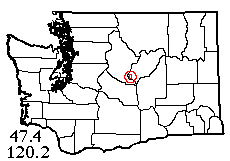 |
![]() 21 VI 2023: The plan looked good on paper. To sample the area containing the city of East Wenatchee, we'd start at a large cemetery for Laurel's grave-vase spiders project, then do moister habitats along a public riverside trail, and end up with a nice county-owned sagebrush tract. The cemetery part worked out well. Laurel got 4 species from the vases, including both sexes of an Erigone that I don't recognize at all, maybe new to the state. Conifers in the middle and rabbit brush on the slope above yielded little or nothing, but Douglas-firs at the edge had two more species, one a Dictyna that I also don't recognize. So we blithely proceeded to the Apple Capital Trail.
21 VI 2023: The plan looked good on paper. To sample the area containing the city of East Wenatchee, we'd start at a large cemetery for Laurel's grave-vase spiders project, then do moister habitats along a public riverside trail, and end up with a nice county-owned sagebrush tract. The cemetery part worked out well. Laurel got 4 species from the vases, including both sexes of an Erigone that I don't recognize at all, maybe new to the state. Conifers in the middle and rabbit brush on the slope above yielded little or nothing, but Douglas-firs at the edge had two more species, one a Dictyna that I also don't recognize. So we blithely proceeded to the Apple Capital Trail.
But the trail (paved) was not along the riverbank, as appeared from above, but a good 50 feet higher, mostly atop a bluff or at least a quite steep slope. Habitats reachable from trailside were very dry. Leaf litter gave me one spider; bridge railings had none. Pine cones (non-native) were better, adding 4 species including our very first specimen of the "spitting spider" Scytodes thoracica. Sagebrush, seemingly productive, added just one and sweeping, one more. Nothing new from pine foliage and tree-of-heaven flowers. (That lush stand of tree-of-heaven is likely to prove a big liability when the rapidly-advancing hordes of Spotted Lanternfly arrive). In tiny Ballard Park, blue spruce foliage (non-native of course) added one more, for a subtotal of 13, so far.
Our hopes now rested on that nice big sagebrush tract. Imagine our shock on arriving to find that, since Google Earth's street view was taken, it's been plastered all over with "No Trespassing, Douglas County Property" signs! The tract has no structures to vandalize, so what the heck do they think they're protecting? How dare they bar the public from entering what a naive person like me would suppose is public property? So anyway, we drove on up Badger Mountain Road looking for alternate sites. Sagebrush land in plenty, but every time we saw something good (including a powerline right-of-way), more Keep-Out signs! Finally, a tract that might have been perfect — but it was over the border of the gridspace. Meanwhile, unpredicted rain squalls drifted through. In the end, we settled on a tract by a water tower that had some good sagebrush (though so dry that the rain just fallen made nothing wet). Looking at aerial photos later, I saw this as only a tiny triangle of habitat surrounded by wheatfields. Serenaded by a soothing meadowlark, between us we added 4 good species beating sagebrush (a 5th I was sure I'd collected, must have missed the vial); Laurel added one good one each from under a rock, under a soil clod and sweeping herbs. Then time caught up with us, leaving us with 20 species, "an hour late and a species short."
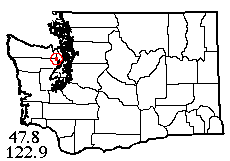 |
![]() 29 VI 2023: An announced freeway closure, plus hot weather predicted for some destinations, brought us back to the cool Olympic Peninsula. Due west of Quilcene is a foothill valley featuring the Little Quilcene River, Lords Lake (a restricted access town watershed), and Penny Creek with associated roads and habitats, in gridspace 7829, the very last to sample in the "square degree" bordered by 47, 48, 122 and 123. We got off to a bad start at Quilcene Cemetery, where the grave vases were largely mud-clogged. Next, we headed for the highest point in our area on Deadfall Creek. This site featured a nice grassy field where 4 roads come together; grassy roadsides; riparian alder along the creek; and diverse (but fern-dominated) understory. Also, noisy target shooters in a quarry a quarter-mile up the creek.
29 VI 2023: An announced freeway closure, plus hot weather predicted for some destinations, brought us back to the cool Olympic Peninsula. Due west of Quilcene is a foothill valley featuring the Little Quilcene River, Lords Lake (a restricted access town watershed), and Penny Creek with associated roads and habitats, in gridspace 7829, the very last to sample in the "square degree" bordered by 47, 48, 122 and 123. We got off to a bad start at Quilcene Cemetery, where the grave vases were largely mud-clogged. Next, we headed for the highest point in our area on Deadfall Creek. This site featured a nice grassy field where 4 roads come together; grassy roadsides; riparian alder along the creek; and diverse (but fern-dominated) understory. Also, noisy target shooters in a quarry a quarter-mile up the creek.
But no one interfered or asked silly questions as I swept 5 species from the field, Laurel supplementing this with 5 more from roadside grass. I got no new spiders from alder litter, but between us we added 7 from moss and 6 from ferns; Laurel topped off with a solitary aerial-web Metellina, making 23 from our first site. Next, I planned to "clean up" on conifer-foliage fauna at a site we'd passed just outside the fenced area of Lords Lake. I hadn't realized the trees I planned to beat, just off a side road, were on well-hidden downslopes and their branches just a bit too far off the ground to easily reach. I did manage to add three species from the few branches I could reach, while Laurel swept two more from the lower-elevation grass. Now, hoping to make a second start in more productive terrain, we returned down the Little Quilcene Road to U.S. 101 and ascended Penny Creek Road a bit farther south.
A few miles up this road, we stopped at a pre-selected creekside to have another go at litter and moss. Better! The litter added three species including one of the always-welcome Ozyptila, and the moss added Neon reticulatus. For our final site, we stopped at a recent clearcut where I added 5 good species from the young Douglas-firs, and Laurel found a couple of female gnaphosids under fallen bark that turned out to be uncommon Callilepis pluto. From an unpromising start, we ended the day with 40 species! And we hit the return ferry perfectly, thanks to their being off schedule due to a stuck truck on the boat we came over on!
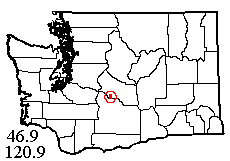 |
![]() 14 VII 2023: For the first time since 2019, my Finnish friend, lepidopterist Markku Savela, was in town, armed with his customary rough-road-ready SUV. After some medical delays, I arranged a very suitable field trip with promising spider habitat for Laurel and me, and butterflies for Markku: the Righthand Fork of Rock Creek, which drains into the Naches River near Cliffdell. A lengthy gravel road ascends from river level to well over 5000 feet, and at first was not bad for driving. After several miles it began to have rough patches, and after we left the main line to reach my planned site of high lake and meadows, it was really a jeep trail that, in a town car, we'd have had to walk. But we found the very spot I wanted, and the meadow sweeping was good! It didn't take me too long to sweep 8 species, and I saw 2 more in my net that somehow didn't find their way into the vial. In marshy ground beside the lake, a number of pompilid spider wasps were prowling on the mud, probably finding spiders that eluded me; and that was where I swept the very first "phantom crane fly," Bittacomorpha occidentalis, I've ever seen! I also beat 9 spider species from conifer foliage, where Laurel had less-good luck but did add one species I'd missed.
14 VII 2023: For the first time since 2019, my Finnish friend, lepidopterist Markku Savela, was in town, armed with his customary rough-road-ready SUV. After some medical delays, I arranged a very suitable field trip with promising spider habitat for Laurel and me, and butterflies for Markku: the Righthand Fork of Rock Creek, which drains into the Naches River near Cliffdell. A lengthy gravel road ascends from river level to well over 5000 feet, and at first was not bad for driving. After several miles it began to have rough patches, and after we left the main line to reach my planned site of high lake and meadows, it was really a jeep trail that, in a town car, we'd have had to walk. But we found the very spot I wanted, and the meadow sweeping was good! It didn't take me too long to sweep 8 species, and I saw 2 more in my net that somehow didn't find their way into the vial. In marshy ground beside the lake, a number of pompilid spider wasps were prowling on the mud, probably finding spiders that eluded me; and that was where I swept the very first "phantom crane fly," Bittacomorpha occidentalis, I've ever seen! I also beat 9 spider species from conifer foliage, where Laurel had less-good luck but did add one species I'd missed.
Markku was also getting quite a few decent butterfly photos; but Laurel was having terrible luck! She tapped 100 of the normally-productive Ponderosa pine cones, for zero spiders; and swept a Veratrum-dominated meadow habitat (where I would have expected at least Pityohyphantes) for … nothing! At this elevation, dead wood habitat is usually great, and after quite a struggle I finally got into a patch of closed-canopy forest that had some. I got a reasonable number of nice-looking spiders there too, but in the end only 2 species were identifiable. I did get the trip's only mature wolf spider there though. Meanwhile, Laurel finally got lucky when she decided to try the cones from a white-pine tree she found. Eureka! Just a little change in cone architecture translated into six spider species including what really seems to be a new species of the ant-mimic Micaria. Laurel and Markku also both found one each of the little gnaphosid Callilepis eremella active on the road.
With a long drive home, it was time to head out, but we were able to make another stop 1000' lower where the Righthand fork had grown into a respectable stream. Here, we added 6 species (2 from my understory sweep and 4 from Laurel's rock-turning), for an acceptable total of 28 — and that one great Micaria!
 |
![]() 19 VII 2023: With inland sites drying out, we repeated a past strategy and headed for the coast: in this case, the lowest, tidal reach of the Humptulips River before it reaches salt water on the north shore of Grays Harbor. First, a brief stop at Fern Hill Cemetery, Aberdeen where the 10 species taken included Laurel's grave-vase spider. Then, on to that boat launch on the Humptulips, at a spot just below the bridge where the river splits around a jungly-looking island. There was too much traffic to safely collect from the bridge, and riverbank grass produced little, so our main habitats were understory, litter and moss in the riparian alder forest. We both swept understory for 7 species; Laurel sifted moss for 3 more; and I sifted litter, adding 4. One Clubiona from a retreat brought our total so far to 14. Not too far off, one annoyed-sounding coyote voiced an occasional whoop.
19 VII 2023: With inland sites drying out, we repeated a past strategy and headed for the coast: in this case, the lowest, tidal reach of the Humptulips River before it reaches salt water on the north shore of Grays Harbor. First, a brief stop at Fern Hill Cemetery, Aberdeen where the 10 species taken included Laurel's grave-vase spider. Then, on to that boat launch on the Humptulips, at a spot just below the bridge where the river splits around a jungly-looking island. There was too much traffic to safely collect from the bridge, and riverbank grass produced little, so our main habitats were understory, litter and moss in the riparian alder forest. We both swept understory for 7 species; Laurel sifted moss for 3 more; and I sifted litter, adding 4. One Clubiona from a retreat brought our total so far to 14. Not too far off, one annoyed-sounding coyote voiced an occasional whoop.
I had planned two secondary sites for this gridspace. The first, to the west, was along the shore of North Bay just outside a natural area preserve. A very deep, wet ditch had to be bypassed, then we had to negotiate blackberry vines and ground with lots of unexpected holes before I reached the spruce tree I wanted to beat. After all that, it added only one species; and Laurel, battling the viney, brushy tangle that looked like a beach meadow, never got into any productive sweeping. So, we moved on to my last preselected site, Grass Creek Wildlife Unit, right along the side of a named side road from the highway — which turned out to be signed, private, keep out! The legality of barring entry to a road alongside public land seems dubious to me, but…
However, I'd seen plenty of spruce trees along the highway just to the west, and we no sooner headed that way than Laurel spotted a sort of driveway leading to a gate with a huge grassy field beyond: and not a keep-out sign in sight! Maps call the place Gray Gables. We parked, she headed past the gate to sweep, while I worked on spruce (added 7 species) and salal (added 3 more). Laurel's sweep sample (with a bit more from me) added another 4, doubling our riverside sample from this unplanned, serendipitous site. A nice Sitticus/Attulus jumping spider from double retreats in the field (where a tidal channel of Grass Creek meanders through) topped it off for a nice final total of 31. We decided to dine at Smitty's in Elma on the way home.
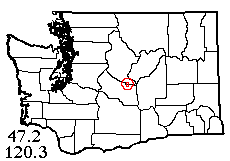 |
![]() 26 VII 2023: When I discovered the existence of Mission Ridge Ski Area, it sounded like a great place to collect. Two treeline gridspaces, reached by an excellent paved road south from Wenatchee, and on public (Forest Service) land. We should have done it as early as possible, but events intervened, and here we were in late July. I had hoped to ascend a ski-run service road to a higher elevation, but it was authorized-vehicles-only. Time being rather short, we decided to stay in the 4600' elevation gridspace rather than hike it. A nice, green willow stand beside the parking lot unfortunately had no good litter on the too-steep ground. So to start with, Laurel discovered an old road across the Squilchuck valley from the parking lot. It was gated (hardly necessary, nobody could have driven it) and passed from flowery meadow to rocky forest: promising!
26 VII 2023: When I discovered the existence of Mission Ridge Ski Area, it sounded like a great place to collect. Two treeline gridspaces, reached by an excellent paved road south from Wenatchee, and on public (Forest Service) land. We should have done it as early as possible, but events intervened, and here we were in late July. I had hoped to ascend a ski-run service road to a higher elevation, but it was authorized-vehicles-only. Time being rather short, we decided to stay in the 4600' elevation gridspace rather than hike it. A nice, green willow stand beside the parking lot unfortunately had no good litter on the too-steep ground. So to start with, Laurel discovered an old road across the Squilchuck valley from the parking lot. It was gated (hardly necessary, nobody could have driven it) and passed from flowery meadow to rocky forest: promising!
Sweeping the meadow growth in the old road and the nearby understory did get us some spiders: five species in all. Laurel added two under log bark. My best habitat here was under rocks, where I added five good spider species and a good centipede, despite a few that got away. But no other habitats we tried here added any more. Looking at our photos after the fact, I wonder if I should have sifted the moss patches in the tiny brook or scrambled down into the Squilchuck Creek ravine: what they call "Monday morning quarterbacking," I guess.
Back on the side where we were parked were some firs and pines with low branches (though showing some browned foliage patches) along roads and trails. In the time remaining, I beat conifer foliage, adding five more species. Laurel got one more from the outside of the lodge building. Our final total for the long drive, a disappointing 18. Everything seemed lush, and it wasn't too hot, but I guess the season was just too late. We'll have to go back!
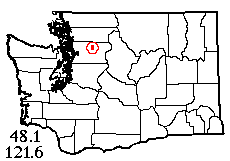 |
![]() 1 VIII 2023: I'd been planning for some time to collect at Eight Mile Creek Trail (south of Darrington) with Jerry Austin. Should have done it at least 2 weeks earlier, but Jerry had other fish to fry, so here we were at a mid-elevation forest late in the season. However, the road to the trailhead wasn't as bad as expected, though bad enough to scrape the belly of Jerry's little car in a few places where it looked like the rocks weren't that big. Anyway, Eightmile Creek actually had a little water in it, and soon after that we were at the trailhead, a habitat with roadside verge, semi-mossy alders, western hemlock, fairly diverse understory, and dead wood to sample. Jerry wanted to hike from the 1720' elevation trailhead to Squire Creek Pass (around 4100'), so he soon began to climb, leaving me the solitary human at the trailhead.
1 VIII 2023: I'd been planning for some time to collect at Eight Mile Creek Trail (south of Darrington) with Jerry Austin. Should have done it at least 2 weeks earlier, but Jerry had other fish to fry, so here we were at a mid-elevation forest late in the season. However, the road to the trailhead wasn't as bad as expected, though bad enough to scrape the belly of Jerry's little car in a few places where it looked like the rocks weren't that big. Anyway, Eightmile Creek actually had a little water in it, and soon after that we were at the trailhead, a habitat with roadside verge, semi-mossy alders, western hemlock, fairly diverse understory, and dead wood to sample. Jerry wanted to hike from the 1720' elevation trailhead to Squire Creek Pass (around 4100'), so he soon began to climb, leaving me the solitary human at the trailhead.
I began by sweeping roadside verge, with not-bad results of 5 species swept and a big Neriene litigiosa from her dome in a bare roadside shrub. Alder litter was next, and added another 5; 11 already! But moss sifting was a disappointment, and added only Ethobuella tuonops. There was a diverse understory, especially along the first part of the trail, and beating the foliage gave me what looked like a diverse fauna, and actually did add 3 more species. I got a fair number of spiders from western hemlock foliage, which was abundant where the mostly-boulders creek crossed the road, but this added only Araniella displicata. As the light faded, I tapped dead wood in the forest and hoped I was getting at least a few more species, but this added only Cybaeus reticulatus. My total for the day's work: only 17 species. I had brief encounters with only 3 other people.
Meanwhile, Jerry did make it to the subalpine habitats of Squire Creek Pass. He beat conifers in the parkland, getting 5 identifiable species of which 2 added to my 17. He spent his remaining time turning over slabs of rock that rested on a bedrock substrate, a somewhat unusual situation where it was awkward to catch the spiders, but he managed to get mature Orodrassus canadensis and Zelotes rainier (the day's best species), plus a penultimate Micaria that I'll probably be able to identify, making our day's total a barely-enough 21-22 species. He had underestimated how long it would take to hike down the very rough trail in the dusk, and was 40 minutes past the agreed time (with me considering my options if he didn't make it!) when his ghostly figure appeared at the trailhead. Driving home, we were just too late to catch the sunset.
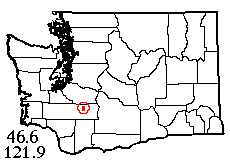 |
![]() 12 VIII 2023: Hoping my time-tested strategy of splitting a day between low and high elevations would work again, I talked Laurel into a late season trip to the Catt Creek area, in Lewis County SW of Mt. Rainier. Delayed only by an accident ahead (a school bus had hit a motorcycle!), we easily found our starting place, where forest Road 85 crosses well-watered Catt Creek at about 2800' elevation. On the upslope side of the road, I swept 4 species from the roadside, added one from streamside understory, and 5 more from conifer foliage including rare Dipoena daltoni. Below the road, Laurel found 4 species (including a Micohexura of all things) under the bark of a standing dead tree and 3 more under creekside rocks, but nothing different on vegetation. We now had our head start of 17 species in good time, but it was hard to get Laurel back to the car to head upward (she couldn't hear me calling over the stream noise).
12 VIII 2023: Hoping my time-tested strategy of splitting a day between low and high elevations would work again, I talked Laurel into a late season trip to the Catt Creek area, in Lewis County SW of Mt. Rainier. Delayed only by an accident ahead (a school bus had hit a motorcycle!), we easily found our starting place, where forest Road 85 crosses well-watered Catt Creek at about 2800' elevation. On the upslope side of the road, I swept 4 species from the roadside, added one from streamside understory, and 5 more from conifer foliage including rare Dipoena daltoni. Below the road, Laurel found 4 species (including a Micohexura of all things) under the bark of a standing dead tree and 3 more under creekside rocks, but nothing different on vegetation. We now had our head start of 17 species in good time, but it was hard to get Laurel back to the car to head upward (she couldn't hear me calling over the stream noise).
Once on our way, I had three sites to check out along the way: first, what I'd thought might be a big maple tree (but big alders look similar from the air, noted for our way back). Second, there was a big meadow just off the road, at least that's what I thought. It was really an impenetrable tangle of willows and shrubs, nothing to sweep here folks! One thing worked out well here, under Gifford Pinchot National Forest management we didn't have so many decommissioned roads to deal with; all the side roads were open and maintained! Now, up above us was a nameless ridge including a 5120' peak, and we were able to drive right up it, past my third site-for-checking, what looked like an old growth stand. Well, this stand was indeed unlogged, but few of the trees were big, and though there was plenty of dead wood in it, the wood disappointingly produced no spiders.
While I was being "skunked" at my dead-wood site, Laurel (parked on the 4700' ridge crest) added one species from conifers, a second from sweeping subalpine flowers, and a third under rocks. Walking up the road in forest shade to rejoin her, I added two more from conifers (thinking I was getting more). Laurel witnessed the "touching" reunion of a woman in one white jeep with two guys in another, for whom she'd been angrily waiting some 4 hours! Anyway, we thought we probably had our sample, but wanting some insurance, we stopped on the way down by that group of big alders; a fortunate spot. Although the alder litter was pretty dry, I sifted 4 species from it including unexpected Hexura picea. Laurel found a late-surviving spring wolf spider, Pardosa vancouveri, active at near dusk, and though she got no spiders under the boulders of a small rock-pit, she did find a live bat sheltering there! We came away with a sufficient 26 species. On the way home, we stopped at two cemeteries but without finding any of the undescribed grave-vase spider this time.
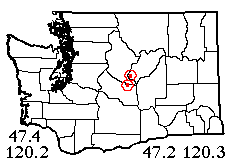 |
![]() 23 IX 2023: Having failed to get a full sample on both 21 June (East Wenatchee) and 26 July (Mission Ridge), I thought we could polish off both on a single trip in another season, since both are a short drive from Wenatchee. Choosing a day when rain was due west of the Cascades, we proceeded to Wenatchee and stopped first at Wenatchee Cemetery, where Laurel found the same Erigone autumnalis that was a new state record at the East Wenatchee cemetery in June, but not the grave-vase lepthyphantine that's found in most western Washington cemeteries. So, onward to East Wenatchee and superior (we hoped) steppe-land habitats around the trailhead for a 1-mile hike we didn't take to historic, primitive Hamilton Cemetery.
23 IX 2023: Having failed to get a full sample on both 21 June (East Wenatchee) and 26 July (Mission Ridge), I thought we could polish off both on a single trip in another season, since both are a short drive from Wenatchee. Choosing a day when rain was due west of the Cascades, we proceeded to Wenatchee and stopped first at Wenatchee Cemetery, where Laurel found the same Erigone autumnalis that was a new state record at the East Wenatchee cemetery in June, but not the grave-vase lepthyphantine that's found in most western Washington cemeteries. So, onward to East Wenatchee and superior (we hoped) steppe-land habitats around the trailhead for a 1-mile hike we didn't take to historic, primitive Hamilton Cemetery.
Another feature of the Hamilton trailhead is an electrical substation, where someone has planted juniper ground cover and several pine trees; Laurel was looking forward to collecting from the pine cones. Alas, they were Scots pine and the cones contained no spiders! However, the pine foliage wasn't so bad and produced 4 species for us, 3 adding to the sample. Juniper foliage added two more. It's a good thing the artificial planting was there, because beating sagebrush and rabbit brush plus sweeping grass added nothing to our June list. But now we already had our minimum number of spider species.
Before leaving East Wenatchee, it seemed desirable to get some species off buildings, which we hadn't done in June, and a few blocks away from the trailhead was the large Eastmont Junior High School building, its exterior suitably rough-surfaced. Nothing was going on there this Saturday (no home game for the Eastmont Bobcats, evidently) so we were able to circumnavigate the structure, extracting spiders from walls, stairwells, windows, valve boxes, ornamental shrubs and a blue spruce tree. Surprisingly, a lot of the spiders were black widows! We wonder if the students are educated not to carelessly pick up spiders from their school building… Other school spiders were diverse: 2 salticids, 2 agelenids, 2 dictynids, a linyphiid, and a so-far-unidentified cobweb weaver, so after these 2 sites our June sample of 18 species had become 31 and we were off to Mission Ridge!
In July, we'd sampled two sites on both sides of the high valley containing the ski resort, so this time we began centrally and made our way down one side of the ravine of Squilchuck Creek. From some service buildings there, Laurel collected 5 spider species, including adults of "cat-faced" Araneus gemmoides and three that added to the list, unfortunately including invasive Metellina segmentata. A little lower down by some kind of covered pit, I sifted fairly dry leaf litter for 3 species; understory beating got me little but did add a Helophora. Laurel got just one spider from a Douglas-fir cone, but it added to the list (it was a species I'd also taken at the school). Both of us beat very productive conifers (mainly Engelmann spruce — wear gloves while beating!) for 8 species, 2 adding to the list. Bottom line: an 18-species sample boosted to a satisfactory 27. Success! Darkness was already descending, and after dining in Wenatchee it was much too late for sunset.
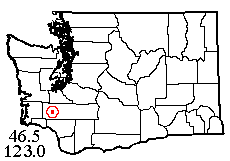 |
![]() 1 X 2023: Laurel was missing in action (actually in Europe), but nature blogger Dan Nelson wanted very much to learn how spiders are collected, and agreed to drive on a trip to an area of private (but accessible) forest tracts in a range of hills west of the Winlock-Evaline area, Lewis County. A few years ago, I'd made a trip plan that involved driving south on Cousins Road to a powerline clearing and a Sierra Pacific gate. But things chage over the years; the powerline grassland was now posted and inaccessible, and the forest to the north had just been clearcut. But good old Sierra Pacific hadn't changed; their land was still accessible, and good! We walked past the gate, up to a junction, and down a side road to a semi-creek with a few alders, and set up to sift leaf litter and moss.
1 X 2023: Laurel was missing in action (actually in Europe), but nature blogger Dan Nelson wanted very much to learn how spiders are collected, and agreed to drive on a trip to an area of private (but accessible) forest tracts in a range of hills west of the Winlock-Evaline area, Lewis County. A few years ago, I'd made a trip plan that involved driving south on Cousins Road to a powerline clearing and a Sierra Pacific gate. But things chage over the years; the powerline grassland was now posted and inaccessible, and the forest to the north had just been clearcut. But good old Sierra Pacific hadn't changed; their land was still accessible, and good! We walked past the gate, up to a junction, and down a side road to a semi-creek with a few alders, and set up to sift leaf litter and moss.
The leaf litter wasn't too productive, but gave us 5 spider species; moss on the same trees added 7. I set Dan to beating ferns, which added 4 more species. One more from sweeping roadside grass here, made 17. Then I backtracked to the junction where there was a 2019/20 clearcut already planted with Douglas-fir; more and better roadside grass (which added 5 more species for a minimum sample of 22); and some fairly tall timber with a rich salal understory. Dan (delayed by fern-beating) soon arrived and I set him to beating the young conifer branches. Once I'd finished sweeping, I began beating salal, which was spider-rich indeed with mature Agelenopsis, Misumena, Ceraticelus, Hyptiotes, native Ero canionis, Spirembolus mundus, uncommon Anyphaena pacifica and more. Dan's tree-beating added 7 more species (including our second Anyphaena species and the introduced Ero tuberculata), for a total of 36 up to this point. While we were at the clearcut, some horseback riders came through; Dan had noticed a few horses wandering in the clearcut earlier.
Maybe we should have stayed right there, scanning for ground-active species and turning over the abundant wood in the clearcut, perhaps finding more litter back by the gate. But I had two other sites nearby my curious nature wanted to check out. The first, an apparent grassy clearing along Brown Road, turned out so small we didn't even stop. But the last site, a rich riparian meadow on King Creek, did look good when we arrived (by a somewhat roundabout route). No doubt the tract is marshy at times, but now after a dry summer, it was plenty dry enough to traverse. The trouble was, sweeping the grass (which we both did) just didn't produce very much. There was a nice native orbweaver (the ones on the Sierra Pacific land were introduced), but all juvenile. I added two nice species from sifting maple litter, but the maple tree's leaves hadn't even turned color, let alone fallen. Dan found a good female Bassaniana crab spider under bark, making only 3 species to add for a day's total of 39, still very satisfactory. Dan did get a lot of specimens from beating red cedar, including two interesting harvestmen species, but the spiders in this habitat duplicated earlier records. Still a productive day, in essentially perfect weather.
 |
![]() 8 X 2023: The week after my trip with Dan, I took advantage of an field trip offer from Sayna Parsi, a young lady who'd stopped by my lab recently to learn something about spiders. She clearly enjoyed her baptism in field work. We headed south again, to an area some 9 miles west of the previous trip, along the Pe Ell-McDonald Road, beginning at a small marsh on Halfway Creek. Just as we stepped off the road I spotted a nice wolf spider, Tarentula kochii, a good sign. Two of us sweeping (and managing to avoid stepping into hidden water-filled holes) brought us only 5 more species, but still better than the similar habitat where Dan and I swept last week.
8 X 2023: The week after my trip with Dan, I took advantage of an field trip offer from Sayna Parsi, a young lady who'd stopped by my lab recently to learn something about spiders. She clearly enjoyed her baptism in field work. We headed south again, to an area some 9 miles west of the previous trip, along the Pe Ell-McDonald Road, beginning at a small marsh on Halfway Creek. Just as we stepped off the road I spotted a nice wolf spider, Tarentula kochii, a good sign. Two of us sweeping (and managing to avoid stepping into hidden water-filled holes) brought us only 5 more species, but still better than the similar habitat where Dan and I swept last week.
Now we recrossed the road to where we'd parked by a gated timber track where I saw no keep-out signs, and walked up the track (which follows Halfway Creek toward its source) through a shady riparian alder-conifer forest, some of the alders satisfyingly mossy. We sifted two bags of very decent alder litter, adding 9 spider and 3 harvestman species. I set Sayna to beating ferns while I sifted moss for 8 further species, and her fern beat topped off the site with 5 more including a very unusual-looking Ceratinella, making 28 spider and 4 harvestman species so far. A quarter mile upstream, our track crossed a powerline right-of-way where there was some salal to beat. This salal only added 3 spider and one harvestman species, but included a male Ceratinella that might go with the female from the ferns. There was no route eastward along the powerline, but westward and up a hill, it passed into a clearcut where I hoped to find conifer foliage. That hope wasn't realized, but we found some extraordinarily spider-rich grass. Unfortunately, the vial full of the grass-sweep sample here somehow managed to disappear on the way home!
But I think most of the species in the missing vial were duplicated at our last site, about a mile's drive west near Jones Creek, where lots of Douglas-fir foliage bordered a roadside grass field on open Manke Timber Co. land. Beating these trees actually brought us 23 species, including some great records like Neoscona arabesca and Tmarus angulatus (both spotted by Sayna's young eyes). I beat a female Ero tuberculata from Scots broom, supplementing the native E. canionis in the sift samples. Given these results, the barking dogs at a house across the road were just a trifle. A lush salal stand along the Manke timber road brought us up to a spectacular area total of 50-52 spider and 7 harvestman species! Now the sunny weekend ended with clouds rolling in, so I didn't get much of a sunset picture. Sayna enlivened the trip home with verbal word games.
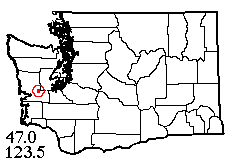 |
![]() 21 X 2023: Laurel had returned from Europe on Tuesday, and by Saturday she was ready for the field (though still jet-lagged) at the tail end of another spell of suitable weather. We picked the site with the warmest forecast, a state river-access on the West Fork Satsop River, just above where it joins the East Fork to become just plain Satsop. The day was cloudy but otherwise pleasant. I knew from Street View that there was plenty of blackberry here, but we found a parking spot farther along the loop of side road where it wasn't bad enough to matter much and there was some lovely conifer foliage. I beat Sitka spruce, Douglas-fir and red cedar, getting a fine start of at least 16 species. Interestingly, the invasive Philodromus dispar seemed to prefer the cedar foliage here. A roadside sweep added 2 and beating ferns on a shady bank added 11 more, for a healthy sample of 28 plus some good harvestmen.
21 X 2023: Laurel had returned from Europe on Tuesday, and by Saturday she was ready for the field (though still jet-lagged) at the tail end of another spell of suitable weather. We picked the site with the warmest forecast, a state river-access on the West Fork Satsop River, just above where it joins the East Fork to become just plain Satsop. The day was cloudy but otherwise pleasant. I knew from Street View that there was plenty of blackberry here, but we found a parking spot farther along the loop of side road where it wasn't bad enough to matter much and there was some lovely conifer foliage. I beat Sitka spruce, Douglas-fir and red cedar, getting a fine start of at least 16 species. Interestingly, the invasive Philodromus dispar seemed to prefer the cedar foliage here. A roadside sweep added 2 and beating ferns on a shady bank added 11 more, for a healthy sample of 28 plus some good harvestmen.
A steep bluff separated our spot from taller forest below, but Laurel found an easy descent farther along the road, giving us access to a flood plain with lovely big maples and alders, easily crossed to the gravel bar beyond. I was able to get two bags of mainly-maple litter from protective crotches where it was safe from the devouring invasive earthworms. This litter was fairly rich in spiders, adding 8 more species. Laurel had added 5 more from moss on the trunks, and fallen moss "clods" added one Ozyptila, her favorite crab spider.
While I was doing the "big habitats," Laurel wandered about sampling this and that. The outhouse added 4, dead wood and a sweep along the edge of the gravel bar added one more each, and the gravel bar itself added 2. Some interesting agglomerations of flood debris that were perched on the branches of riverside trees and shrubs, had 11 species, two of them adding to the list. Finally, getting toward 5 pm, we had some light sprinkles of rain (to the tune of distant thunder). I thought I'd try sifting some alder litter before we left, but just a couple of spiders into this sift, the clouds burst! Even that final sift added another species. Our total for the site was an outstanding 54 spider species or more, plus 8 of harvestmen.
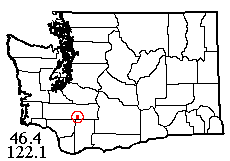 |
![]() 29 X 2023: Laurel was unfortunately unavailable on Halloween (which late the previous week had the best weather forecast), but I found a site where the weather looked good on Sunday the 29th: Taidnapam Park at the east end of Riffe Reservoir, Cowltz River. Dan Nelson had wanted to join the two of us for a joint trip, so I arranged for him to come north from his Vancouver base and rendezvous at Morton. Originally I thought we could meet at Spiffy's Drive-in, but Laurel preferred the town cemetery! As we drove south, weather was fair and sunny, but we did see occasional ominous patches of frost. However, at the cemetery it wasn't too cold, and Dan awaited us. I beat 4 species from juniper shrubs while Laurel sampled the grave-vase habitat she is studying, getting two microspider species including the undescribed lepthyphantine she was looking for. Morton was already sampled, but this visit enhanced it from 28 species to 32.
29 X 2023: Laurel was unfortunately unavailable on Halloween (which late the previous week had the best weather forecast), but I found a site where the weather looked good on Sunday the 29th: Taidnapam Park at the east end of Riffe Reservoir, Cowltz River. Dan Nelson had wanted to join the two of us for a joint trip, so I arranged for him to come north from his Vancouver base and rendezvous at Morton. Originally I thought we could meet at Spiffy's Drive-in, but Laurel preferred the town cemetery! As we drove south, weather was fair and sunny, but we did see occasional ominous patches of frost. However, at the cemetery it wasn't too cold, and Dan awaited us. I beat 4 species from juniper shrubs while Laurel sampled the grave-vase habitat she is studying, getting two microspider species including the undescribed lepthyphantine she was looking for. Morton was already sampled, but this visit enhanced it from 28 species to 32.
The two vehicles caravaned east to the park, parking just inside the main entrance. Dan and I collected near here from conifer foliage and fern-majority understory, getting between us 26 species from these habitats; Dan's included the two most interesting, Rhomphaea fictilium and one male Lepthyphantes I don't recognize at all. While beating, I had a short, friendly talk with a curious park employee who had no problem with spider collecting. Meanwhile, Laurel had hiked all the way south to the river, where she collected from a footbridge, gravel bar and outhouse, adding 5 species mainly from the latter. She returned to the parking area for sifting, where I'd begun to sift maple litter, not getting very much. At this point Dan headed home and I switched to cottonwood litter, while Laurel began sifting moss. It was a little on the chilly side, and that might explain why neither type of litter produced any Linyphiidae, though adding 6 macro-spider species. As usual in borderline temperatures, Laurel had better luck with the moss, though adding only 3 to species from other habitats.
I just managed to drag Laurel away from the moss in time to visit the potentially most interesting habitat, a large tract of grassland on terrain cleared for reservoir inundation, but exposed for some years due to lower water levels. We accessed it via a closed boat launch (nowhere to launch a boat with the lake so low) and the sun still warmed the grassy expanse for a little while longer. But we didn't get very far sweeping it; it was so tall and dense, we could hardly see the decidedly irregular ground, so progress was very slow. However, we managed to sweep 6 species before the sun sank behind the hills, the most interesting being Laurel's Tmarus angulatus crab spider. We spent some time on salal, young conifers and an outhouse, all these habitats adding nothing, but Laurel found a Lepthyphantes leprosus on the car and insists it must be from the park (though it's a species I would have thought to find back home in Seattle). In any case, a fine overall 47-species total.
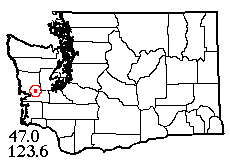 |
![]() 31 X 2023: There was a Halloween trip after all, thanks to the enthusiasm of new volunteer-recruit Kathy Whaley. I can't claim nothing went wrong on our trip to the lower Wynoochee River (chosen for the warmest weather forecast), yet we were successful anyway, and certainly had a lovely day for it! Jerry decided to come along, and picked this trip of all trips to bring a friend; but after we got them in our car bound for the south, a complicated set of mishaps left them stranded on a Seattle street while Kathy and I (both feeling highly apologetic) proceeded alone. Fog on the freeway fortunately cleared before we reached Montesano. Soon we were tooling up Black Creek Road to my first goal, a section belonging to a small timber company, which unfortunately turned out to be posted. Beginning some roadside collection before heading for the next site, I discovered I'd left my camera at home! Fortunately, that was the day's last stroke of ill fortune.
31 X 2023: There was a Halloween trip after all, thanks to the enthusiasm of new volunteer-recruit Kathy Whaley. I can't claim nothing went wrong on our trip to the lower Wynoochee River (chosen for the warmest weather forecast), yet we were successful anyway, and certainly had a lovely day for it! Jerry decided to come along, and picked this trip of all trips to bring a friend; but after we got them in our car bound for the south, a complicated set of mishaps left them stranded on a Seattle street while Kathy and I (both feeling highly apologetic) proceeded alone. Fog on the freeway fortunately cleared before we reached Montesano. Soon we were tooling up Black Creek Road to my first goal, a section belonging to a small timber company, which unfortunately turned out to be posted. Beginning some roadside collection before heading for the next site, I discovered I'd left my camera at home! Fortunately, that was the day's last stroke of ill fortune.
Armed with 6 species from Black Creek, we proceeded to the secondary main site, a nice wooded tract, property of the fire department, a small part of it occupied by the Wynoochee Valley Fire Station. We parked and began beating conifers (about half Sitka spruce), for a nice sample of 15 species, highlights being my Metellina mimetoides and Kathy's Rhomphaea. I beat some salal (adding nothing as it turned out) and swept salal and fern understory, adding only one more. Fortunately it was warm enough for good sifting, and a single bag-full of alder-vinemaple litter produced fully 11 additional species, most of which looked just alike to Kathy! Sifting a bag of moss added 3 more. Kathy made this trip's photo album possible with her camera phone.
We could have done more on the fire department's land, but I thought by this time (around 3 pm) the grass must be dry, so we proceeded to our final site: grassy roadsides where Wynoochee Valley Road meets Kirkwood Memorial Bridge, crossing the river to become Geissler Road which runs along Geisler Creek (yes, both spellings are official). Between us we swept 10 species from grass, and Kathy found exactly one Zygiella hiding behind every post holding up the guardrail. Walking across the bridge, she spotted schools of salmon migrating up the Wynoochee! Just as the sun dipped behind the trees, I tried sifting litter from one large bigleaf maple on the riverbank, but it had suddenly become too cold for litter spiders to move. It was worthwhile though, since the one spider I got was an adult male Ozyptila pacifica. Our day's overall total was 39 species.
And then the rains came! Fall collecting season now suspended for the time being.
This page last updated 21 March, 2025